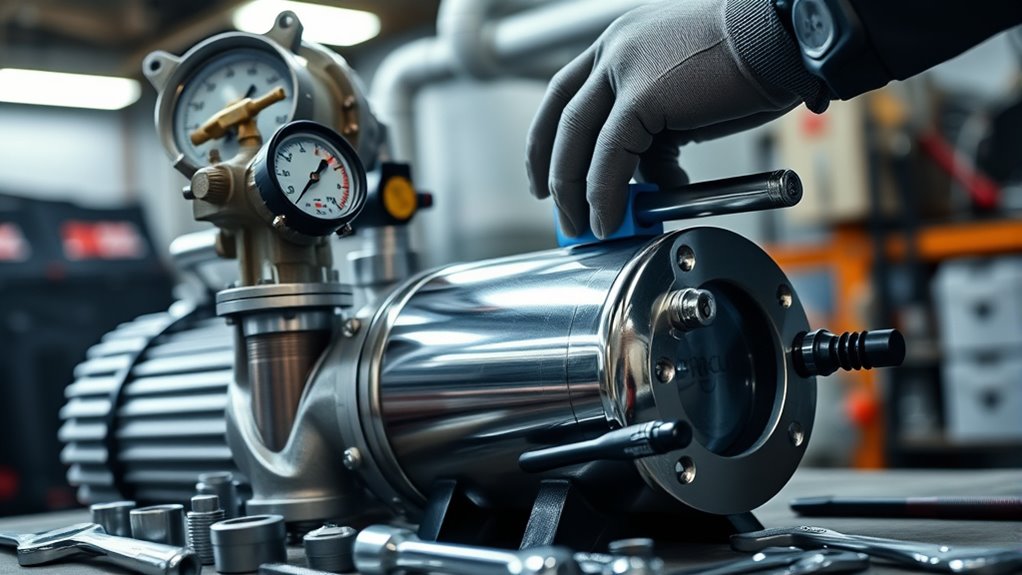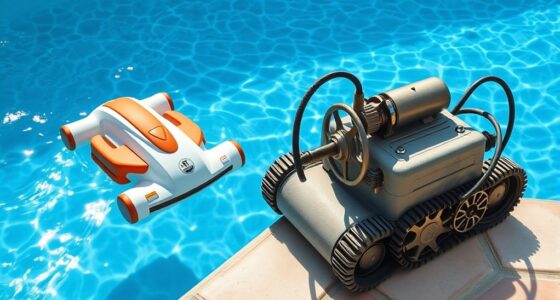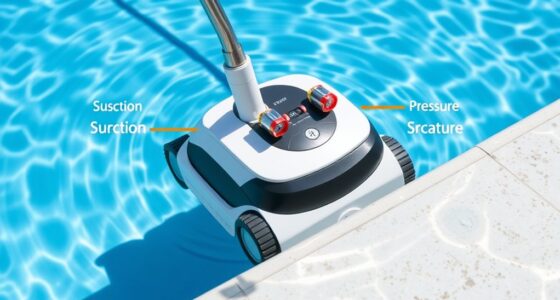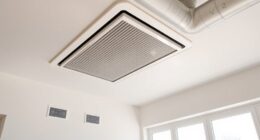To maintain your booster pump, you should regularly inspect and lubricate moving parts, checking for wear and proper operation. Keep an eye on pressure, flow, and unusual noises that could indicate trouble. Clean filters and intake screens often, and promptly replace worn seals, valves, or impellers. Address any leaks or electrical issues early to prevent bigger problems. For more tips on keeping your pump in top shape, continue exploring these essential maintenance steps.
Key Takeaways
- Regularly inspect and lubricate moving parts to prevent wear and ensure smooth operation.
- Monitor system performance using gauges and check for unusual vibrations or noise.
- Check and clean filters, intake screens, and connections to avoid blockages or leaks.
- Inspect and replace worn seals, valves, and impellers to maintain efficiency and prevent failures.
- Address pressure or flow issues promptly by troubleshooting electrical components and system connections.

Regular maintenance is vital to keep your booster pump running efficiently and prevent costly breakdowns. One of the most important aspects of maintenance involves proper pump lubrication. Without adequate lubrication, moving parts can wear out quickly, causing increased friction and heat that may lead to premature failure. Check your pump’s manual to determine the correct type of lubricant and the recommended intervals for application. Regularly inspecting the lubrication points ensures everything stays well-oiled and functioning smoothly. Don’t wait for squealing or unusual noises to act; proactive lubrication keeps parts moving seamlessly, extending the lifespan of your pump.
Along with lubrication, system troubleshooting plays a significant role in maintaining peak performance. If you notice a drop in pressure or flow rate, it’s time to investigate the issue. Start by examining the pump’s inlet and outlet connections for leaks or blockages. Dirty filters or clogged intake screens can restrict flow, so make sure these are clean and unobstructed. Electrical problems like faulty wiring or worn-out switches can also cause operational hiccups. Keeping a checklist handy helps you systematically identify potential issues before they escalate. Regular troubleshooting not only prevents downtime but also saves you money by catching problems early. Additionally, understanding pump lubrication techniques can help prevent issues caused by improper pump operation, especially if your system involves paint or other viscous fluids.
Performing routine performance monitoring can help catch inefficiencies before they become serious problems. Monitoring the pump’s performance parameters is another key step. Pay attention to unusual vibrations, overheating, or excessive noise, as these often indicate underlying issues. If your pump starts running louder than usual, it could be a sign of misalignment or bearing problems—both of which require prompt attention. Using diagnostic tools like pressure gauges and flow meters can help you detect anomalies that might not be immediately obvious. These measurements enable you to compare current performance against baseline readings, making it easier to spot deviations. Regularly maintaining and inspecting the pump components, such as seals, valves, and impellers, is essential because wear and tear over time can significantly impact efficiency. Worn or damaged parts can compromise efficiency and cause leaks, leading to increased energy consumption. Routine system troubleshooting involves inspecting and maintaining the pump’s components, such as seals, valves, and impellers. Worn or damaged parts can compromise efficiency and cause leaks, leading to increased energy consumption. Regularly inspecting these components and replacing them when necessary keeps the system running smoothly. Remember, a well-maintained booster pump not only provides consistent performance but also reduces energy costs and extends the equipment’s lifespan. Incorporate these practices into your maintenance routine, and you’ll enjoy trouble-free operation and peace of mind knowing your booster pump is in top condition.
Frequently Asked Questions
How Often Should I Schedule Professional Booster Pump Inspections?
You should schedule professional booster pump inspections at least once a year. During these visits, they’ll check pump calibration to ensure peak performance and conduct leak detection to prevent costly damages. Regular inspections help catch issues early, extend the pump’s lifespan, and maintain efficiency. If your system experiences heavy use or unusual noise, consider more frequent inspections. Staying proactive keeps your booster pump running smoothly and avoids unexpected failures.
What Are Signs of a Failing Booster Pump?
You might notice signs of a failing booster pump, such as reduced water pressure, strange noises, or frequent cycling. These issues indicate your pump’s lifespan is nearing its end. Keep a maintenance checklist to catch problems early, and don’t ignore irregularities. Regular inspections help you spot wear and tear, ensuring your booster pump operates smoothly longer and prevents costly breakdowns. Stay attentive to these signs for peak performance.
Can I Upgrade My Booster Pump for Higher Efficiency?
Did you know that upgrading your booster pump can boost efficiency by up to 30%? Pump upgrades are a smart way to improve performance and save energy. If you’re considering a higher efficiency model, check compatibility with your system and consult a professional. Upgrading not only reduces energy costs but also extends your pump’s lifespan, making it a worthwhile investment for better, more reliable operation.
What Safety Precautions Should I Follow During Maintenance?
When performing maintenance, always prioritize safety. You should wear appropriate safety gear, like gloves and goggles, to protect yourself from potential hazards. Before starting, verify the emergency shutoff is easily accessible and functioning correctly, so you can quickly disconnect power if needed. Follow the manufacturer’s instructions carefully, and never bypass safety features. Taking these precautions helps prevent accidents and keeps you safe during booster pump maintenance.
How Do Temperature Fluctuations Affect Booster Pump Performance?
A stitch in time saves nine, and that’s true for temperature fluctuations affecting your booster pump. Rapid changes in temperature can cause performance issues, so focus on proper temperature regulation and pump insulation. Insulating your pump helps maintain consistent temperature, preventing overheating or freezing. Regularly monitoring ambient conditions and ensuring proper insulation keeps your pump running smoothly, avoiding costly repairs and downtime caused by temperature-related problems.
Conclusion
Think of your booster pump as the heartbeat of your water system, steady and essential. When you give it regular check-ups and care, it keeps your home flowing smoothly, like a well-tuned orchestra. Neglecting it is like ignoring the engine’s needs—eventually, everything stalls. By maintaining your pump diligently, you’re conducting a symphony of reliable water pressure and endless flow, ensuring your home’s rhythm stays uninterrupted. Keep it tuned, and it will serve you faithfully for years to come.









